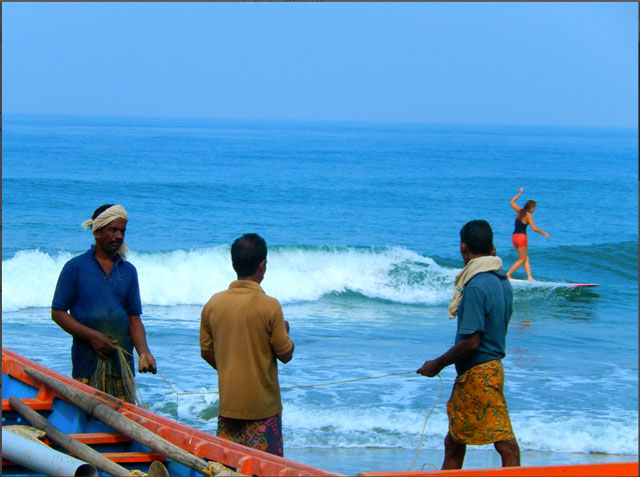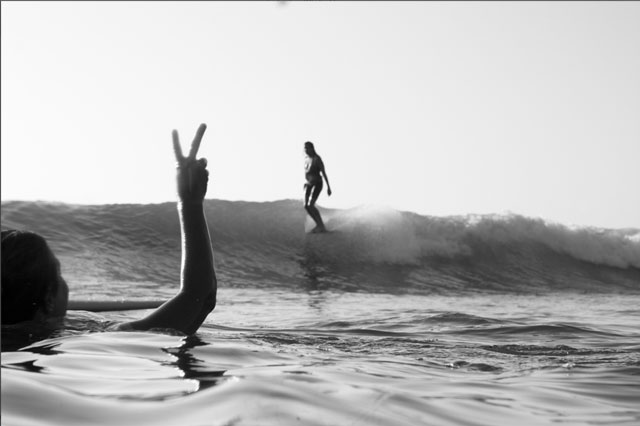Beyond The Surface film touches on themes of women’s empowerment, eco-tourism, engaging youth, biocentrism, and personal growth along the path to perfect waves. Here, Lauren Hill hangs ten. Photo: Knutson
*This article was originally published in White Horses: The Sea has Stories magazine.*
We watched from the tea-tinted water as pilgrims hiked their way up a gentle sloping, sandy headland to the temple of St. Francis Xavier.
Diaphanous sari fabric waved seaward, caught in the offshore breeze. A sea of humans cloaked in bright colors sang, beat drums and enthusiastically proceeded toward their deity’s monument, a newly erected meditation center atop a headland overlooking the Laccadive Sea in the south of India.
A flotilla of women we were; five of us on longboards, riding tiny wavelets that delicately peeled a meter from the beach along a little reef-lined bay. The small bay rounded into a much larger bay that encompassed both a tiny, quiet fishing village and an exceptionally formed sandy right-hander. About three feet of swell exploded against the crook outcropping of rocks.
We’d arrived to this sleepy fishing village in Tamil Nadu on perhaps its most festive day of the year—the birthday of their great patron Saint Francis Xavier. It was good timing for us to witness the village aflutter, but perhaps inappropriate timing for the ceremony. We were underdressed and uninvited, anyway. We had hurriedly driven over from the West Coast and played the almost full-contact Indian driving game for about 10 hours, bobbing and weaving around each obstacle as it came. Cow? Elephant procession? Motorbike man swerving with a 15-foot ladder nestling around his neck? All safely deflected.
We’d been exploring nooks and crannies of the south Indian mainland for waves while shooting for a film called Beyond the Surface with India’s first recognized female surfer, Ishita Malaviya and exploring the usage of surfing as a tool for social development, community building, and sustainability there.
The temptation of swell—any amount of ridable swell—proved irresistible after two weeks of relatively fruitless searching. One of our local surfing connections assured us that there would be good surf in Tamil Nadu. That the sand and swell were right. And so we drove.
~

Emi Koch, founder of the international NGO Beyond the Surface International, gracefully cross-steps on her longboard as local fishermen watch, slightly perplexed at all of the women in the ocean. Photo: Lauren Hill
The pilgrims kept coming. We floated and watched them. They walked and watched us. The fascination was mutual. Dark eyes inquired from behind swathes of sari and Indian translations of “Yew!” (I presume?) lept from beneath black, bushy moustaches as the sun began its descent, saturating the smoke and smog of the Indian subcontinent with a spectrum of sunset hues.
A towering Gothic cathedral in the heart of the village, the remnant of Portuguese missionaries, stood starkly in silhouette. The church, St. Stephens, was the first built by a Saint for another Saint. Saint Francis Xavier landed in Tamil Nadu by shipwreck in the stormy seas of 1548 (one of three nearly fatal shipwrecks in his life).
He was a world-traveling Catholic missionary, inspired by the query of one of his contemporaries, Ignatius of Loylola: “What will it profit a man to gain the whole world, and lose his own soul?”
So Francis Xavier set a’ sail and is largely responsible for spreading and maintaining the influence of Catholicism in India, as well as Borneo, Japan and Indonesia.
The people St. Francis converted were a caste known as Paravars, coastal folk renowned for their pearl fisheries, boat building and sea faring. Their kattumarm, meaning “tied tree” in Tamil (the origin of the word catamaran), design appears very similar to the skillfully built crafts of Polynesia, but seems to have developed independently.
If the Paravars, like Polynesians, developed multi-hulled seafaring vessels, might they have also played amongst the swell and surf? Did missionary invasion also sever them from their hedonistic ocean play, just as Christian missionary invasion nearly extinguished Hawaiian ocean culture?
I got into the habit of asking south Indians about their impressions of the ocean. Did they like it? Did they swim in it?
A beautifully wrinkled 80-year-old Indian woman curled the edges of her mouth down and said bluntly that the ocean was evil. A place of demons. I asked her why, to which she replied, with furrowed brow, “You do not ask Mama why you call her mama. She just is. You do not question it.”
This pervasive tradition of fear about the ocean in India was common. Despite the searing heat, it’s quite rare to see Indians swimming or cooling off in the water.
It’s merely speculation, but could the near death experience of a dogmatic Saint-to-be have tainted the once thriving relationship that the Paravars, skilled waterpeople, once had with the sea?
~

With more than 7,500 kilometers of coastline, India presents the potential for waves to suit all manner of boards and ability levels. Here, Lauren Hill slides across a gently peeling longboard-friendly right-hander. Photo: Knutson
Masses of pilgrims began to gather at the edge of the sea, watching and cheering us sliding across the tiniest of wavelets and floating between micro-mini sets. Our familiar seemed so foreign here. Looking back up to the headland, people mingled and stared down at us.
We had become a diversion from the ceremony. The organizers of the event were not impressed. Word filtered through the crowd, descending until one of our crew waved me in. “It’s time to go,” Tushar said. “They’ve asked us to leave so they can get on with the procession.”
And the tension between religion and spirituality was never more apparent.
I couldn’t help but feel, in that moment, we were somehow competing with god; that great personified, omnipotent, white bearded man in the sky.
Lower case god, that is, the deeply human, inevitably flawed, religious concoction woven of sexist moral codes and troubling social mores—like the caste system or beliefs that deny women autonomy or worth—he seemed threatened in that moment.
Not to be confused with God, the sexless energetic essence that occupies the allegedly empty space between electrons, powers the universe, and has no preferential treatment for converting the masses or conquering cultures.
The act of six women peacefully, quietly riding waves was too great a disruption for organized religion that day. Women in rural India simply do not behave so dynamically, especially not out in the world, amongst men and the raw elements.
We hopscotched over the reefy inside section, greeted by 20 or so men eager to snap candid mobile phone photos of us as we walked by (more people in India have access to cell phones than toilets), and respectfully went on our way.
~
When checking the surf another day, we happened to see a little brown body sprinting toward the ocean, dragging a serious trunk of a coconut palm. He proceeded to paddle and ride white water waves on it. I watched from afar as the crew ran down to film the spontaneous act of surfing. The Paravars must have been surfers. It’s in their genes.
Perhaps that’s why their modern incarnations found our slip sliding so very fascinating?
Surfing has always entwined with the spiritual but it was the rigidity of religion that nearly smothered the surfing out of Ancient Hawaii, and may have succeeded in south India, too.
Perhaps the undulating unpredictability of riding waves splashed too far outside of the rigid bounds of religious tradition, threatening to erode the hierarchies where culture and wild nature collide.
~
Author: Lauren H. Hill
Editor: Katarina Tavčar












Read 1 comment and reply